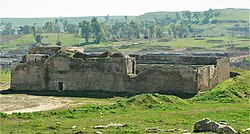Dair Mar Elia
| ܕܝܪܐ ܕܡܪܝ ܐܝܠܝܐ دير مار إيليا |
|

Ruins of the monastery in 2005
|
|
| Monastery information | |
|---|---|
| Other names | Saint Elijah's Monastery |
| Order | Chaldean Catholic Church |
| Established | 595 |
| Disestablished | 1743 |
| Architecture | |
| Status | Demolished, 2014 |
| Site | |
| Location | near Mosul, |
| Coordinates | 36°17′33″N 43°7′52″E / 36.29250°N 43.13111°ECoordinates: 36°17′33″N 43°7′52″E / 36.29250°N 43.13111°E |
Dair Mar Elia (Syriac: ܕܝܪܐ ܕܡܪܝ ܐܝܠܝܐ, Arabic: دير مار إيليا), also known as Saint Elijah's Monastery, was a Christian monastery located just south of Mosul, in the Nineveh Governorate, Iraq. It was founded in the late 6th century, and it was one of the oldest monasteries in Iraq. It belonged to the Church of the East, an ancient branch of Eastern Christianity. The monastery closed in 1743, after its monks were massacred by Persian forces. Its ruins were damaged during the invasion of Iraq in 2003, and it was demolished by the Islamic State of Iraq and the Levant in August or September 2014.
The monastery was founded around 595 AD by Mar Elia, a monk who had previously studied at al-Hirah and later in the great monastery at Izla mountain in modern Turkey. It belonged to the Chaldean Catholic Church. The monastery was the center of the regional Christian community and for centuries thousands of Christians would visit the monastery to observe the Mar Elia Holiday, which falls on the last Wednesday of November.
The main sanctuary of the monastery was built in the 11th century, and it was renovated by Hurmizd Alqushnaya in the 17th century. In 1743, the Persian leader Tahmaz Nadir Shah damaged the monastery and killed the 150 monks who lived there, after they refused to convert to Islam. The monastery lay in ruins until the beginning of the 20th century, when some restoration was completed on a few halls and rooms. During the First World War, Dair Mar Elia was a place of refuge which led to the rebuilding of part of the site. The structure, along with its neighboring reservoir and natural mineral water springs, were cared for by the Chaldean Church, and Christian pilgrims continued to visit the ruins. In the 1970s, the monastery became a base for the Iraqi Republican Guard.
...
Wikipedia

